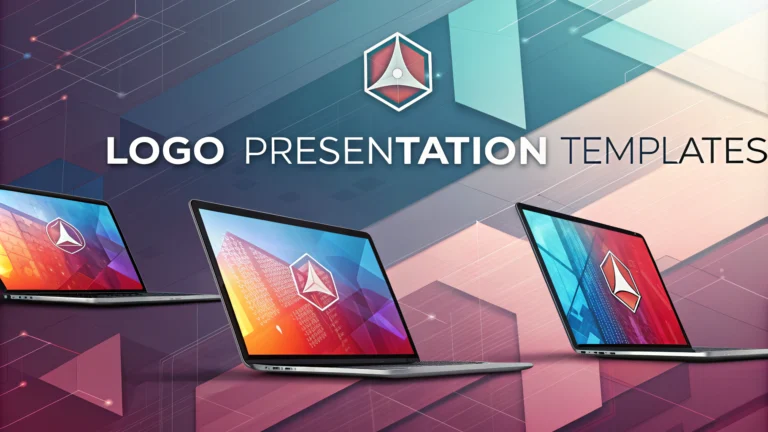Creating professional logo presentations helps designers showcase their work effectively and win more clients.
This quick guide covers practical tips for presenting logos like a seasoned professional.
Essential Logo Presentation Elements
- Brand color variations
- Black and white versions
- Size scaling examples
- Mockups on real products/materials
- Grid system and construction
- Typography specifications
Recommended Presentation Software
| Software | Best For |
|---|---|
| Adobe InDesign | Professional brand guidelines |
| Figma | Interactive presentations |
| Canva | Quick, simple presentations |
Practical Presentation Tips
- Show the logo in context with realistic mockups
- Present maximum 3 concept options to avoid overwhelming clients
- Include brief explanations of design choices
- Demonstrate logo versatility across different mediums
Physical Presentation Materials
Print presentations on high-quality paper stock (recommended: 100lb cover or heavier).
Consider presenting on materials the logo will actually appear on (business cards, letterhead, etc).
Digital Presentation Format
- PDF format for easy sharing
- Web-friendly files under 10MB
- Interactive presentations using Figma or InVision
- Video presentations showing logo animations
File Formats to Include
- .AI (Adobe Illustrator native file)
- .EPS (vector format)
- .PDF (print-ready)
- .PNG (web/screen use)
- .JPG (web/email use)
Consider creating a simple style guide showing proper logo usage guidelines.
Professional Resources
- Behance – Browse professional logo presentation examples
- Mockup World – Free mockups for presentations
- Creative Tim – Premium presentation templates
Remember to get written approval on final logo designs before delivering files.
Contact Information
For professional logo design templates and resources, contact the AIGA (American Institute of Graphic Arts) at 212.807.1990 or visit www.aiga.org.
Presentation Best Practices
Client Meeting Structure
- Start with project goals and objectives review
- Present research and inspiration sources
- Walk through each concept individually
- Allow time for questions and feedback
- Discuss next steps and timeline
Common Presentation Mistakes to Avoid
- Presenting too many options
- Showing unfinished concepts
- Using low-quality mockups
- Neglecting to explain design rationale
- Missing important file formats
Project Delivery
Final Deliverables Checklist
- Master logo files in all formats
- Style guide with usage guidelines
- Color codes (CMYK, RGB, Pantone)
- Typography specifications
- Original mockups and presentations
File Organization
Organize final files in clearly labeled folders:
- Print Files
- Web Files
- Source Files
- Guidelines
- Presentations
Conclusion
Professional logo presentations are crucial for communicating value to clients and ensuring proper brand implementation. Focus on clear organization, high-quality mockups, and comprehensive file delivery to maintain professional standards and achieve client satisfaction.
Always document final approvals and maintain backup copies of all project files. Consider creating a presentation template to streamline future client projects.
FAQs
1. What essential elements should a logo presentation template include?
A professional logo presentation template should include logo variations, color codes, typography details, minimum size requirements, clear space specifications, and examples of correct and incorrect usage.
2. How many logo variations should be presented to a client?
Present 3-4 primary logo variations including the primary logo, secondary logo, icon/symbol version, and a responsive version that works at different scales.
3. What file formats should be included in a logo presentation?
Include vector files (AI, EPS, SVG), raster files (PNG, JPG), and both RGB and CMYK color versions to ensure versatility across digital and print applications.
4. Why is it important to show logo mockups in a presentation?
Mockups demonstrate how the logo will appear in real-world applications, helping clients visualize the logo on various materials like business cards, signage, and digital platforms.
5. How should color variations be presented in a logo template?
Display the logo in full color, monochrome, black, white/reversed, and grayscale versions, along with specific Pantone, CMYK, RGB, and HEX color codes.
6. What spacing guidelines should be included in a logo presentation?
Include clear space measurements (typically using an element of the logo as a measuring unit) and minimum size requirements for both print and digital applications.
7. How should logo rationale be presented in the template?
Present the concept behind the design, explaining the symbolism, color psychology, and typography choices that align with the brand’s values and objectives.
8. What are the essential do’s and don’ts to include in a logo presentation?
Show examples of correct logo usage alongside common mistakes to avoid, such as stretching, color alterations, or incorrect positioning.
9. How should typography specifications be presented?
Include the names of primary and secondary fonts used, along with their various weights and styles, and guidelines for their usage in brand communications.
10. What file naming conventions should be explained in the presentation?
Detail a clear file naming system that indicates the logo version, color mode, and file format (e.g., CompanyName_Primary_CMYK.ai or CompanyName_Icon_RGB.png).







